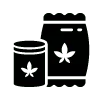- CBDStore.ie Team
- Articles & Blog about CBD
- 0 likes
- 0 comments
CBD oil is a naturally occurring cannabinoid extracted from a resinous flower of marijuana or hemp plant. CBD has become immensely popular. It is being used in more than 500 scientific researches to determine its effect on the human body and its physiological functions.
Hemp contains more than a hundred phytocannabinoids, which have different effects on the human body. Another prominent cannabinoid of the Cannabis plant is tetrahydrocannabinol, responsible for the ‘stoned’ or intoxicated feelings associated with marijuana. Even though there is a minimal difference in THC and CBD's atomic structure, the latter is entirely safe and does not cause any euphoric effect.
How Does CBD Work?
Both THC and CBD interact with our bodies in different ways. Primarily command, they mimic our bodies' function and oogenesis cannabinoids produced by the cell's lipid membranes when they are required. The endogenous cannabinoids have an excellent structure similarity with THC and CBD; that is why these exogenous cannabinoids can replace them in their function.
These endocannabinoid molecules are part of our body's primary cell signaling system called the endocannabinoid system. The receptors of ECS are spread all across the body, maintaining effective signaling between the cells and regulating several physiological processes in the body.
The endocannabinoid system is responsible for our mood, immune activity, blood pressure, bone density, metabolism, pain, stress, hunger, and energy level. Research has shown that over or under activity of the endocannabinoid system may lead to pathological conditions.
CBD Extraction
CBD extraction methods are used to separate CBD from the other phytocannabinoids. It is done in various ways; however, each technique will impact the CBD product's final quality. The four main methods to extract CBD oil is:
- Rick Simpson method
- Carrier oil extraction
- Alcohol extraction
- CO2 extraction
Both companies and consumers agreed that CO2 extraction is the best method to isolate purest forms of CBD. Most companies widely use the supercritical carbon dioxide extraction method. In this method, carbon dioxide is used as a solvent, and it is kept at a particular pressure and temperature. The equipment is used to convert the carbon dioxide into liquid form at a supercritical cold temperature. Supercritical carbon dioxide is passed through the Cannabis plant matter, and the resulting solution is passed through a separator in which cannabinoids are separated from the rest of the chemicals.
Forms of CBD
CBD is accessible in different forms, and the terms used to refer to them can be very confusing. Let's have a good look at different types of CBD and the difference between them.
CBD Concentrates
CBD concentrate contains very high amounts of Cannabidoil. Some concentrates like crumble, distillate, crystals, shatter, and wax contain about 45% to 99.9% CBD oil. If you are looking for a high concentration CBD oil coma, go for this type as small doses of this concentrates will act quickly and produce the desired results.
Raw CBD Oil
Raw CBD oil is produced without using any extraction process that includes the heat of solvents. Raw CBD oil contains other phytocannabinoids, terpenes, and flavonoids. The original plant stays intact, so all pigments and chemical compounds are still there.
The three most famous and commonly available types of CBD are:
- CBD isolate
- Full-spectrum CBD
- Broad-spectrum CBD
CBD Isolate
CBD isolate contains highly filtered CBD, and it does not contain any other cannabinoid or phytochemicals. It contains no THC, and it is generally cheaper than the other types.
Full Spectrum CBD
Full-spectrum CBD contains all essential active cannabinoids, including low dosage of THC. It is also called as a whole plant extract. No chemical compounds are removed in the extraction or filtration process. All the chemical compounds work in synergy to produce the entourage effect.
Broad Spectrum CBD
Broad-spectrum CBD oil is extracted through normal extraction processes, but THC is removed from the extract during the final stages of extraction. Broad-spectrum CBD does not flag positive in a drug test as there is no THC, so it is safe.
How to Incorporate CBD in Our Daily Life?
Incorporating CBD in our daily life was never this easy. Several types of CBD products are available in the market that can be easily used.
Tinctures and Oils
CBD oil and tinctures are produced by the CO2 extraction method. The sublingual dose of CBD tincture gets easily absorbed into the bloodstream and soon shows their effects.
Edibles
For the users who are not comfortable with the earthy and nutty flavor of CBD oil, CBD edibles are a great option. Each serving of the edibles contains a particular CBD dose that is easy to calculate. CBD infused gummies, butter and sauces are delicious and can be used frequently.
CBD Sprays
CBD sprays are an unarguably much easier and quicker way of consuming a CBD dose. You can buy flavored sprays for ease of use and quick effects. Sprays contain microscopic CBD particles that are easily absorbed, and you will not have to feel the weedy taste.
CBD Topical
Topical CBD products have become increasingly popular that include bumps, salves, and creams. It is quite helpful for skin problems and aching muscles. Topicals can also be used after intense workouts and other physical activities.
CBD Vapes
Another quick delivery method to take CBD is vaping. Inhaling CBD will take the dose directly into the bloodstream without any delay through the respiratory track. The effect is quick, but it lasts for a short period.
CBD Capsules
Oral CBD doses take time to show its effect as it has to go through the digestive system to reach the bloodstream. However, the effect will stay for a longer time than other consumption methods.
CBD Dosage
There is no right or wrong dose of CBD. An optimum dose depends on body chemistry, your health condition, the concentration of CBD in each dose, and body weight.
To be on a safe side, make sure to start with the lowest dose, such as 5mg or 10 mg. Stick to the dose for a week and if it does not cause significant changes in your health, increase the dose by 5mg. Keep increasing until you have reached the right dose for yourself.
Side Effects of CBD
Studies have revealed that CBD is entirely nontoxic and does not cause any probable side effects. Our body can tolerate higher doses of CBD. However, some people may experience fatigue, vomiting, weight loss, and appetite changes due to CBD intake. The side effects remain for a short time and fade off rapidly.
If you are taking medicines for anxiety, depression, and other health problems, make sure to consult your doctor before taking a CBD dose. CBD can halt the working of cytochrome P450, which is essential to degrade and eliminate the medication we take.





















Comments (0)